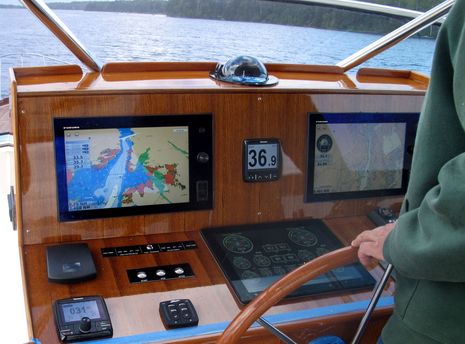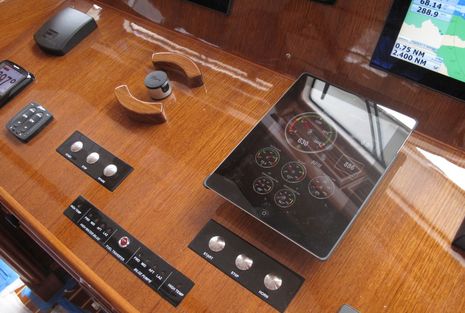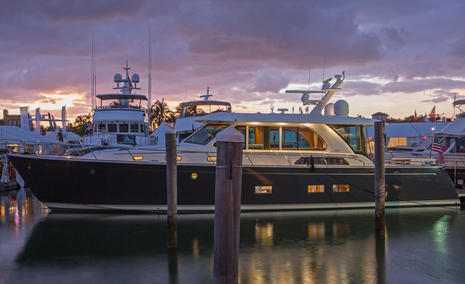Testing a state-of-the-art install: “Many things work!”
A wry line that applies to this and numerous other cutting-edge installs is: “Many things work!” (Though maybe not everything just yet.) This is the 58-foot yacht I mentioned in February when I met the owner at the Miami Show as he planned a nearly complete electronics update. Obviously he decided on the Furuno TZtouch displays that debuted that very day. In fact, while the four TZT14’s on this boat may be some of first installed anywhere and they’re mixed with lots of non-Furuno gear to boot, they seemed to be working quite well. So nicely done, Furuno! But I emphasize “seemed” because it takes a while to wring out a system as complex as this, especially when so much is happening preparatory to delivery day. Heck, guys were varnishing below even as we blasted up the St. George river at nearly 36 knots to check that yet another prop change had fixed vibration issues. And though the techs are joining the owner for the two-day delivery home, it’s still unlikely that they’ll get all the way through the “issues list.” That’s life on the cutting edge. Nonetheless, I think the owner is going to be very pleased with how close the system comes to his vision, and how well it will customize and expand to his future wishes…
If you click that upper photo bigger you’ll see some of the other gear selected. I found it Interesting that the owner chose Raymarine i70 and p70 for instrument display and autopilot heads because they better matched his aesthetic desires. Even without their silver bezels painted black (an option Raymarine might consider?), they match the TZtouch displays better than anything Furuno has (yet), and thanks to NMEA 2000 they’re all sharing data pretty well too. In fact, while one of the few glitches seen on the TZT so far was an inability to display COG and SOG sourced from a Furuno GP33, the i70’s showed those values fine. (The problem turns out to be the source of Magnetic Variation, surprisingly enough, and while Furuno is working on it themselves, I think it’s a little N2K gremlin that effects other systems and deserves investigation.)
Also on this yacht’s N2K bus — which has four power legs and a NBE100 network extender — are oddles of Maretron monitoring info, seen in part on the flying bridge’s KEP touchscreen display. Yes, there are iPads involved too…
The lower helm is very similar to the flying bridge — which is to say clean, sleek and touch friendly — except that a pair of iPads running the N2KView app do the monitoring duty. Incidentally, those TZT screens showing basic engine data (which can also be seen on the i70) wouldn’t be used normally; I was just checking the remarkable redundancy in the overall system (there are non-N2K engine gauges on board too, though tucked away). But while I love the clever “floating” pad mounts created by the crew at Lyman Morse (just mentioned in the PBR entry), these photos also illustrate what may be a problem…
Photos of situations like this almost always look worse than reality but several of us felt like the iPads were hard to see given the glare and the visual contrast with the truly bright Furuno and Raymarine screens (and yes the iPads were turned up to max brightness). But then again they are wireless and maybe it will be easy to, say, add more Vogel’s system base mounts around the helm so the operator can easily shift the pads as needed in certain light conditions.
Note too the matching custom switches and trouble lights that grace these helms (I’ll get the source when I next see the head electronics installer, the methodicial and cheerful Nik DeMaria). But I couldn’t help noticing the few discordant controls that also made it onto these helms, like those Bennett trim tabs. There may have been a sleeker alternative — especially as Bennett added N2K support a long time ago — but I’ve yet to see a totally integrated helm control system anyway. That goal remains elusive, though I’m in agreement with this owner that it’s a worthy goal. It’s reasonable these days to want marine electronics to not only work well but look good…
Now for a peek behind the scenes. Many techs in both Asia and North America have likely been involved in that main panel wiring seen above — and at least one may have an interest in bondage — but what I noted was Nik’s scheme for labeling the many N2K devices in a simple way that references where they tee into the backbone. For instance, “K2-3” means that device is the third one attached to a Maretron multiport that drops from the second tee…
And above is a bunch more NMEA 2000 gear tucked into the back of the engine room. Those Maretron FFM100 fuel flow meters are minding the two gensets while bigger models watch the main engines. What’s noteworthy is the trouble that the Lyman Morse mechanics went to fabricating those stainless brackets to truly secure the hoses and meters and how they mounted it all on a Starboard panel so it will be easier to work on if needed. While the software end of this boat’s elaborate fuel management systems is still a work in process, it will be very interesting to see how it works out. Especially as the main engines themselves are also delivering flow info to N2KView which ought to be able to display both values simultaneously because Maretron has made more use of N2K “instances” than other developers (discussed here).
At any rate, I’ve already got a lot more share about this install plus I hope to visit the boat again before it departs Maine. Among other things I’d like to take more advantage of Furuno’s new screenshot capability. On the TZtouch you can make what’s called the Function Gesture — a two finger double tap — into a screenshot key, or MoB or several other choices. I’m also hoping the TZTs are showing the Class B AIS static data we didn’t see the other day, though that may have been because the antennas were being worked on simultaneously. The boat is a beehive right now, but many things already work well and look good!



















Speaking of how tablets are also changing the game for smaller boats, I think we just went into a new inning with Google’s announcement of the Nexus 7. Its specs smoke the Kindle Fire at the same friendly price of $199, and it’s got the goods to run nav programs and interface with devices like inReach:
http://goo.gl/SpoRl
If Tiffany made nice lamp shades, then Lyman Morse is the ne plus ultra of Yacht Craft
Sunlight readable is a big thing to me.I once purchased a video camera that was useless outside because of the screen.The ipad and iphone are pretty useless too in the sun.My Canon camera’s screen is pretty good outside.
If only they could all copy the transflective screen in my Garmin GPsMAp60 handheld that is brilliant in the sunlight.
Ben,
Any idea why they didn’t use a distributed power system, given that the owner is clearly into this kind of stuff? There are a number of options out there now.
It just seems a bit of a shame. Or did they start down that route and back off for some reason?
Since I’ve just pulled all the old wiring out of my boat, and will be starting the installation of a C-Zone system in about a month, I’d be interested in any feedback on that.
Cheers,
Paul.
Very impressively neat wiring job! I suppose expected on such a yacht. I am a bit confused… Can’t these Furuno or similar be set to display all instrument data.. engine info GPS, sped log, wind and so forth on different screens? If so… why not simply have several of them in a line set to display different *screens*. My old ray C70 has selectable pages and I assume if I had a bunch of the I could have a different page on each one and cover all the instrument data on these devices.
So why the iPads, and the ray displays? Am I missing something? Is this an attempt at redundancy.. different mfgs running quasi independently?
While the install at the helm is beautifully done, the entire *aesthetic* to my eye.. varnished wood and high tech instrumentation is a bit of anachronism and jarring. I don’t know the solution of mixing good old brightwork with high tech… but I haven’t seen the combination successfully pulled off (to my eye).
It IS always a problem planting all sorts of different devices with their own graphic/aesthetic attributes and making them work together visually.
Paul, the schedule on this project was always tight. I’ll put up some “before and after” shots in a future entry but besides all the electronics and helm furniture changes, this boat got three feet added to her stern! The owner also had a pretty strong sense of how far he wanted to go digitally, at least on round one. I’m not sure that actual distributed power will ever be in the cards but some of its features like digital switching could be added to the N2KView system fairly easily.
Jeff, it’s true that you can display many common data values like depth or engine RPM on any one of those displays. But I see that as flexibility not waste. In fact, if it were my project and budget no issue, I might have used two i70’s at each helm. There’s so much you can do with them, and often better than you can on the other displays.
Meanwhile the TZtouchs are so fantastic at charting, radar, sonar, and AIS graphics that I’d rather keep numbers off those screens, and I think that what’s this owner has in mind too. And, finally, neither the Furuno nor Raymarine are remotely close to N2KView in terms of engine and system monitoring and alarming, and N2KView is also handling the four fixed cameras on board. (There was hope to share those with the TZT’s but that’s an unresolved issue.)
Lots on N2KView here:
http://www.maretron.com/products/N2KView.php
Ben – Those stainless brackets securing the hoses are probably standard pipe clamps made by several manufacturers. At mcmaster.com they are known as “Weld-Mount Vibration-Damping Clamps for Pressurized Lines”.
I often use the just the plastic core for mounting various things to rails, a monitor to a pole, etc.
Jon
Thanks, Jon; it’s definitely possible that I got confused about that detail. I was a little overwhelmed! But it is noteworthy that Lyman Morse has a really serious metal fab shop even if they didn’t make those brackets.
Your bog is tremendously interesting and informative, but just what is n2k that you and others often mention?
Regards, Adrian
Adrian;
N2K is shorthand for NMEA2000. This is one of the technologies that is used to connect devices together on boats / ships.
On a typical boat you might find instruments, chart plotters, sensors, etc all interconnected using NMEA2000.
It’s quite different than the old way of interconnecting, which was called NMEA0183. One of the differences is that NMEA2000 is a ‘bus’ system where the old NMEA0183 was more of a point to point system (that sometimes required multiplexers or other such devices to achieve multiple device signal sharing
NMEA devices from most manufacturers are generally able to converse with each other quite well. Some manufacturers have chosen to use non-standard plugs / sockets on their NMEA2000 systems but adapters are available for most combinations.
Hope that helps
RB
How much better are the Furuno TZTouch displays than everything else on the market? There must be something incredible about them to justify $5-7K for 9″ or 14″ displays.
Lovely Stuff, If only I had the money. but I can dream…
Steve
It did turn out that the Furuno TZT’s are not getting complete AIS info over NMEA 2000 from the Raymarine AIS 650. It’s not a matter of deciphering particular PGNs but rather getting all of them; apparently targets can appear fine but then disappear. I suspect that the problem is on the Furuno side, and know they’re working on it, but in the meantime this boat is going to get a Furuno AIS transponder instead.
Hmmm…apparently the FA-50 didn’t work right with the TZT’s either, not even a single one instead of the network of four.
Wow, really impressive!
I’m wondering why the owner didn’t go for any digital switching solutions such as Octaplex, MasterBus, CZone or even Capi2. It seems to me it would reduce lots of complexity to the panel (which is masterfully laid out), save some weight along the way, and most importantly have control of the panel and power distribution from any of the helm stations.
This is a really cool project, keep us in the loop if you hear anything further!